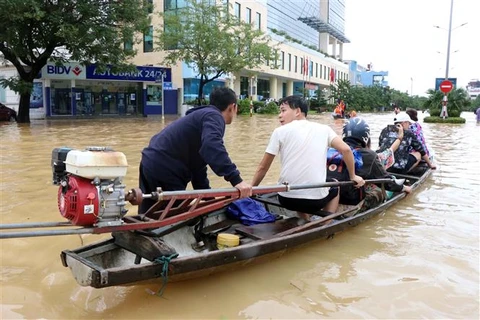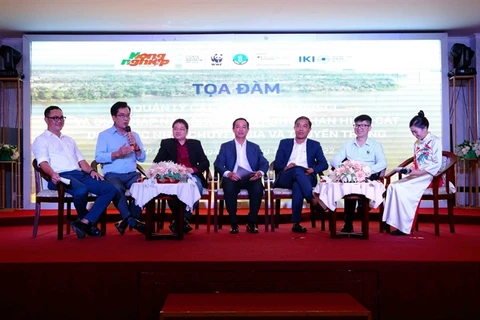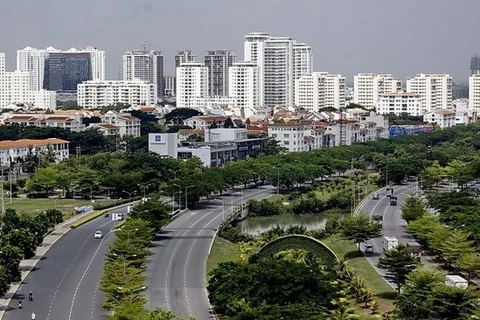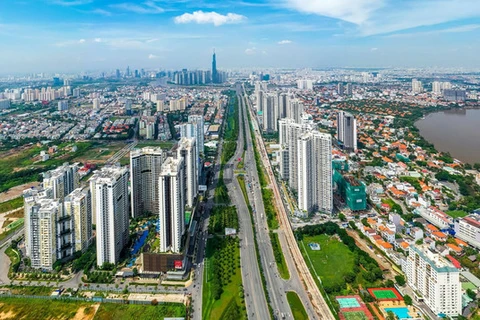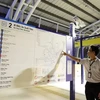Hanoi (VNA) – Alongside urbanisation, flooding in cities of Vietnam, a country highly vulnerable to climate change, is getting complicated and needs concerted solutions, according to experts.
There are more than 800 cities nationwide, including the two special municipalities of Hanoi and Ho Chi Minh City.
Big and populous cities such as Hanoi, Ho Chi Minh City, Da Nang, and Vinh of Nghe An province have frequently suffered from heavy losses caused by downpours and flooding.
Nguyen Van Tien, Deputy Director of the Vietnam Disaster Management Authority under the Ministry of Agriculture and Rural Development, said Vietnamese cities, especially major ones, are centres of economic, social, and cultural activities and also concentrations of infrastructure facilities and residential areas. They are exposed to many disaster risks, including flooding, which requires proactive preventive and timely response measures.
However, disaster response measures for cities have yet to receive due attention. The application of science and technology to disaster risk management in urban areas remains limited. Guidance for safe urban management, especially in terms of housing, water drainage, and tree planting, hasn’t been carried out concertedly.
Dr Seneka, Director for climate response of the programme on urban resilience to climate extremes in Southeast Asia (URCE) of the Asian Disaster Preprardness Centre, said that in 2015, there were more urban residents (54%) than rural ones (46%) around the world. At least 61% of the global population are predicted to live in cities by 2030.
Therefore, it is important to improve cities’ resilience through early warning and quick response. The resilience of cities means that of their individuals, communities, organisations, enterprises, and systems to survive, adapt, and develop, according to the export.
In 2022, many localities took actions to prevent and fight urban flooding.
Among them, some in the northern and north-central regions have been implementing an EU-funded project to improve the climate resilience of urban infrastructure. They consist of Phat Diem township (Ninh Binh province), Ngoc Lac township (Thanh Hoa province), Hoang Mai town (Nghe An province), and Huong Khe and Thach Ha townships (Ha Tinh province).
About measures for climate change adaptation in Vietnamese cities, Hoang Thi Thao, Director of the Climate Change Department under the Ministry of Natural Resources and Environment, held that it is necessary to survey and assess climate change impacts, create climate maps for cities, and include climate issues in strategies, plans, and risk warnings for these areas.
In addition, authorities should overhaul policies on urban development and planning amid growing climate change risks, implement structural solutions to mitigate negative impacts of climate risks, issue appropriate resettlement measures, increase communications to raise authorities and communities’ capacity, and boost scientific and technological researches to develop green, smart, and ecological cities adapting to climate change, she noted./.
There are more than 800 cities nationwide, including the two special municipalities of Hanoi and Ho Chi Minh City.
Big and populous cities such as Hanoi, Ho Chi Minh City, Da Nang, and Vinh of Nghe An province have frequently suffered from heavy losses caused by downpours and flooding.
Nguyen Van Tien, Deputy Director of the Vietnam Disaster Management Authority under the Ministry of Agriculture and Rural Development, said Vietnamese cities, especially major ones, are centres of economic, social, and cultural activities and also concentrations of infrastructure facilities and residential areas. They are exposed to many disaster risks, including flooding, which requires proactive preventive and timely response measures.
However, disaster response measures for cities have yet to receive due attention. The application of science and technology to disaster risk management in urban areas remains limited. Guidance for safe urban management, especially in terms of housing, water drainage, and tree planting, hasn’t been carried out concertedly.
Dr Seneka, Director for climate response of the programme on urban resilience to climate extremes in Southeast Asia (URCE) of the Asian Disaster Preprardness Centre, said that in 2015, there were more urban residents (54%) than rural ones (46%) around the world. At least 61% of the global population are predicted to live in cities by 2030.
Therefore, it is important to improve cities’ resilience through early warning and quick response. The resilience of cities means that of their individuals, communities, organisations, enterprises, and systems to survive, adapt, and develop, according to the export.
In 2022, many localities took actions to prevent and fight urban flooding.
Among them, some in the northern and north-central regions have been implementing an EU-funded project to improve the climate resilience of urban infrastructure. They consist of Phat Diem township (Ninh Binh province), Ngoc Lac township (Thanh Hoa province), Hoang Mai town (Nghe An province), and Huong Khe and Thach Ha townships (Ha Tinh province).
About measures for climate change adaptation in Vietnamese cities, Hoang Thi Thao, Director of the Climate Change Department under the Ministry of Natural Resources and Environment, held that it is necessary to survey and assess climate change impacts, create climate maps for cities, and include climate issues in strategies, plans, and risk warnings for these areas.
In addition, authorities should overhaul policies on urban development and planning amid growing climate change risks, implement structural solutions to mitigate negative impacts of climate risks, issue appropriate resettlement measures, increase communications to raise authorities and communities’ capacity, and boost scientific and technological researches to develop green, smart, and ecological cities adapting to climate change, she noted./.
VNA

